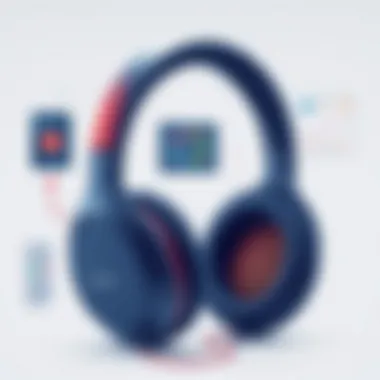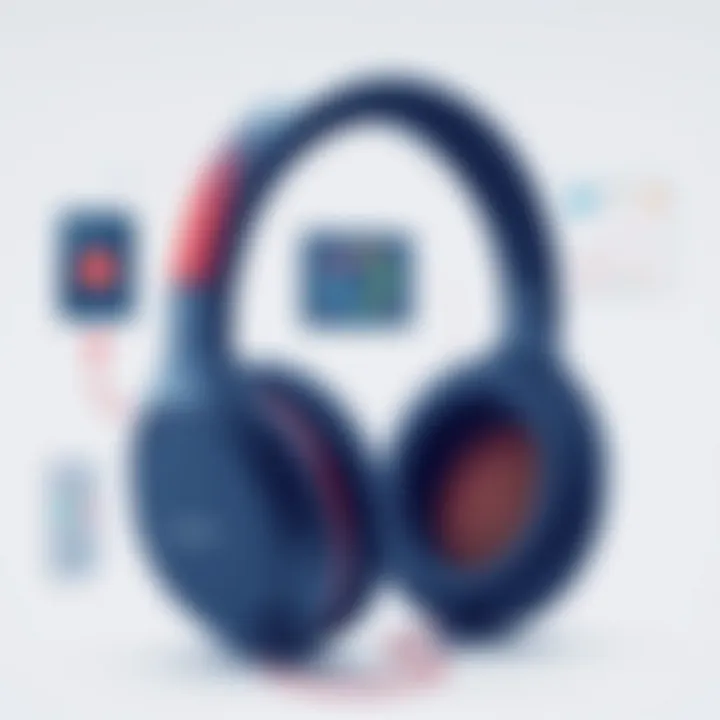Ear Pads for Sony Headphones: A Complete Guide


Overview of the Product
When it comes to headphones, the ear pads often don't get the attention they deserve. Yet, they play a critical role in the overall listening experience, particularly for Sony headphones, which many users have grown fond of due to their impressive sound quality and comfort.
Purpose and Benefits
The primary purpose of ear pads is to provide a cushion between the ear and the headphone driver. This cushioning serves multiple benefits: it enhances comfort during long listening sessions, assists in sound isolation, and can even have a noticeable impact on sound quality. High-quality ear pads can make a world of difference, especially for those who enjoy deep bass and intricate highs. Furthermore, they help keep external noise at bay, allowing you to immerse yourself in your music or gaming without interruption.
Target Audience
The target audience for ear pads designed for Sony headphones largely comprises tech enthusiasts, audiophiles, gamers, and everyday users who appreciate good sound. Each group may have different priorities; gamers might prioritize noise isolation and comfort for longer sessions, while audiophiles might focus on the materials used to enhance sound fidelity.
Key Features
When selecting ear pads, keep an eye out for the following features:
- Material Quality: Look for memory foam, leather, or velour. Each material has its pros and cons, impacting comfort and sound.
- Compatibility: Ensure the pads match your specific Sony headphone model to guarantee a seamless fit.
- Design: Consider the ear pad shape—over-ear pads often provide better sound isolation compared to on-ear.
"The right ear pad can not only enhance your listening experience but can also prolong the life of your headphones by reducing wear and tear."
Materials Used in Ear Pads
The choice of material in ear pads significantly impacts user experience. Here are common types:
- Memory Foam: Molds to the shape of your ear, providing a snug fit. Excellent for long listening sessions but can retain heat.
- Leather: Offers a premium feel and good sound isolation. However, it may not be the best for breathability.
- Velour: Breathable and soft. Great for comfort, but can let some sound leak out.
Selecting the right material requires understanding personal preferences and intended use.
Compatibility Factors
When choosing ear pads, compatibility is crucial. Sony headphones come in various models such as WH-1000XM4 or MDR-7506, each requiring different ear pad styles. Ensure that you check the model number before making a purchase. This attention to detail helps in avoiding unnecessary returns and enhances your overall satisfaction.
Maintenance Tips for Ear Pads
Taking care of your ear pads can extend their lifespan. Here are a few tips:
- Regular Cleaning: Wipe down your ear pads with a moist cloth to remove sweat and dust.
- Avoid Overexposure: Keep your headphones away from direct sunlight; it can damage the materials.
- Replacement: Don’t hesitate to replace worn-out ear pads. The comfort and quality of sound can deteriorate if they are too old.
Staying informed and attentive to these details will ensure that your listening experience stays top-notch.
The Importance of Ear Pads in Headphones
In the realm of audio devices, the significance of ear pads often takes a backseat to more glamorous features like sound drivers or noise-cancellation technology. However, ear pads are not just a secondary accessory; they play a critical role in determining your overall listening experience. From sound fidelity to comfort, ear pads directly influence how music, podcasts, and games are perceived.
Defining Ear Pads and Their Role
Ear pads, commonly referred to as ear cushions, are the pieces of padding that envelop your ears while you use headphones. They act as the first line of defense against the invasion of external noise and are pivotal in delivering sound directly into the ear canal. Their primary function is two-fold: to provide comfort during prolonged use and to enhance sound isolation. The materials and designs can vary widely, ranging from soft foam to luxurious leather. Understanding their role is essential for any auditory enthusiast.
Impact on Sound Quality
Effect on Bass Response
The bass response in headphones is heavily dependent on the ear pad type employed. When you choose thicker, denser ear pads, you’re likely to experience more amplified bass. This phenomenon occurs because the padding material can help create a better seal around the ear, allowing low frequencies to resonate more effectively. The key characteristic of enhanced bass is its ability to deliver a more immersive experience, especially in music genres like hip-hop or electronic dance. However, dense ear pads can sometimes compromise mid-and high-frequency clarity, leading to a more colored sound profile.
Influence on Sound Isolation
Another critical aspect of ear pads is their influence on sound isolation. Good ear pads can effectively block out background noise, letting you focus on your audio without distractions. Ear pads made from materials such as memory foam or silicone can significantly improve isolation by creating a snug fit around your ears. This not only enhances your listening experience but also protects hearing by allowing lower volume levels in noisy environments. However, the downside can be heat buildup, which might lead to discomfort over extended listening periods.
Comfort and Ergonomics
Material Choices


When it comes to comfort, the choice of material for ear pads can't be underestimated. Materials like foam, leather, and velour each provide unique benefits. For example, leather might offer a luxurious feel and is typically easier to clean. Foam, on the other hand, is often lighter and provides a good balance of comfort and sound isolation. The key characteristic to consider here is how well a material can contour to the shape of your ear without causing fatigue. However, high-temperature settings or excessive sweat can degrade some materials, making them less durable over time.
Design Considerations
Also crucial are the design elements of ear pads. Over-ear designs may provide better isolation and comfort since they don’t press against your ears directly. Conversely, on-ear designs tend to be more portable and often lighter but may sacrifice some comfort during extensive use. The unique feature of ergonomic design is its impact on long-term wear; well-designed ear pads can lead to less fatigue and greater satisfaction. It’s important to look for ear pads that not only fit well but also complement the overall headphone architecture.
Material Types for Sony Headphone Ear Pads
Choosing the right material for ear pads can greatly influence both the user experience and the overall performance of Sony headphones. Different materials bring distinct characteristics that affect comfort, durability, sound quality, and maintenance. This section explores various types of ear pad materials, focusing on the unique advantages and drawbacks of each, to help you make an informed decision.
Foam Ear Pads
Foam ear pads are like the bread and butter of headphone cushioning. They're often seen as a go-to option due to their softness and light weight.
Pros and Cons
The primary advantage of foam ear pads is their ability to conform to the shape of your ears. This provides a snug fit that improves isolation and comfort. However, the trade-off is that foam can wear down over time, losing its supportive properties. Additionally, while they often keep sound leaked to a minimum, they might not provide the best ambiance for bass-heavy genres, because their absorbent nature can sometimes muffle deeper tones.
When you get down to it, you’ll find foam pads to be popular because they are economical and easy to find. Many users appreciate this material for casual listening, especially if they don’t mind replacing them periodically.
When to Use Foam
Foam ear pads are ideal for users seeking convenience without breaking the bank. If you find yourself using headphones for shorter bursts, say while working on a project or enjoying a podcast, then foam is a fitting choice. The soft touch can feel very pleasurable during quick sessions, particularly in cooler temperatures, as they don’t conduct much heat.
However, it is crucial to consider your usual listening habits. If you're planning marathon gaming sessions or lengthy music binges, foam may not be the best long-term option due to the potential for discomfort that can arise with extended use.
Leather and Protein Leather Ear Pads
Swapping to leather pads can elevate your experience quite a bit. They encompass both real leather and protein leather, and each provide unique benefits that can cater to a more discerning audiophile.
Durability Aspects
Leather and protein leather ear pads typically boast a longer lifespan than their foam counterparts. The materials are more resistant to wear and tear, meaning you won't have to worry as much about replacing them frequently. For those who find joy in high-quality audio, investing in leather pads can be a smart move. Due to their durability, they often withstand the rigors of daily use better than foam.
However, durability comes at a price. You can expect leather pads to feel warmer during extended use, as they do not breathe as well as foam. Users might find themselves adjusting to a less comfortable fit during the hotter months.
Comfort Features
On the flip side, leather pads often provide a luxurious feel that many users crave. They can create a solid seal around the ears, enhancing sound isolation and delivering a more immersive audio experience. This is particularly evident in bass-heavy tracks, where the tight fit emphasizes deep, rich tones effectively.
However, it’s worth noting that the initial break-in period can sometimes be uncomfortable. Users may need to wear them a bit to allow the material to yield and adapt to the shape of their head.
Velour Ear Pads
Velour ear pads have gained a niche following for those prioritizing both audio quality and comfort over exhaustive listening periods.
Breathability Factor
When it comes to breathability, velour ear pads have a leg up on most other materials. The fabric construction allows air to circulate, preventing any excessive heat buildup during prolonged usage. This attribute makes them a popular choice for users who tend to wear headphones for hours on end.
While the soft texture gives a luxurious touch, it may not offer as snug a fit as leather or foam, potentially allowing sound to escape if not properly sealed against the head.
Suitability for Long Listening Sessions
Velour pads, without a doubt, excel in scenarios where comfort is crucial. If you’re the type to binge on audio books or immerse into gaming sessions that stretch for hours, you’ll likely appreciate the soft touch of velour over the more rigid or warmer materials. Although they might not provide quite the same level of isolation as leather, the comfort factor definitely reigns supreme for extended use.
Choosing the right ear pad material is a crucial decision for any Sony headphones user. Each material presents a compelling case depending on your specific needs and listening habits. Whether you lean towards foam for casual use, leather for durability, or velour for breathable comfort, understanding the characteristics of each type can lead to a markedly improved headphone experience.
Choosing the Right Ear Pads for Sony Headphones
Selecting the correct ear pads for your Sony headphones is akin to picking the right pair of shoes; if they don't fit right, you’re uncomfortable, and it spoils the whole experience. The ear pads not only affect comfort but also have implications on sound quality and overall user satisfaction. A well-chosen pair of ear pads can transform your audio experience, providing lush soundscapes and ensuring long hours of wear without discomfort. This section will discuss essential considerations for ensuring you make the right choice.


Compatibility Considerations
Identifying Your Model
When it comes to headphones, knowing your specific model is half the battle won. Every Sony headphone model, from the WH-1000XM4 to the MDR-7506, has distinctly sized ear pads tailored to fit snugly and perform well. Measuring your current pads or checking the model's specifications will give insight into what size and shape you need.
The main advantage of identifying your model lies in achieving a perfect fit. The right-sized pads create a secure seal around your ears, enhancing audio isolation and improving bass response. This is particularly significant because a poor fit can lead to sound leakage, distorting the intended listening experience. Moreover, getting the correct pads for your model ensures you won’t have unnecessary hassle during installation, avoiding the headache that comes with mismatched parts.
Universal vs. Model-Specific Options
When deciding between universal ear pads and those made for specific models, it’s essential to weigh your options carefully. Universal pads can fit a variety of headphones but may not provide the same level of acoustics or comfort as model-specific options.
Universal options tend to offer flexibility in use and often can be found at a lower price point. However, they might not deliver the stellar performance found with dedicated pads tailored for a specific Sony model. If you value sound quality and immersive listening, going for model-specific pads is usually the better route, even if it costs a little more. There's no one-size-fits-all, and understanding these options is crucial for making the right choice.
Evaluating Thickness and Size
Standard vs. Custom Sizing
Sizing isn’t a one-size-fits-all solution, especially with ear pads. You’ve got standard sizing for most models, but custom options are also available. Standard pads are easily accessible and come in sizes that commonly match Sony’s popular headphone lines, ensuring most users can find something suitable without the fuss.
However, if you’re an audiophile or use your headphones extensively, investing in custom-sized pads can lead to enhanced comfort and sound quality. The unique tailoring of custom pads can cradle your ears just right, preventing fatigue during long listening sessions. Although this might come at a higher cost, the personal fit can be well worth it.
How Thickness Influences Sound
The thickness of your ear pads plays a vital role in audio performance—thicker pads tend to enhance bass response due to their ability to form a better seal. When choosing thickness, consider your listening habits. If you enjoy bass-heavy music, thicker ear pads might be your best friend.
On the flip side, thinner pads can provide a more open sound, which can be favorable for genres that hinge on clarity as opposed to weight. That sound signature can make it feel as though the music is coming from all around, rather than constrained within the headphones. Thus, understanding how thickness influences sound is crucial for a tailored experience.
Brand Reputation and Reviews
Understanding User Feedback
In the digital age, you can tap into a wealth of user reviews to gauge how a particular ear pad performs across different users. Understanding user feedback lets you see beyond marketing claims and into real-world experiences, which is invaluable for weighing your options.
User feedback often highlights aspects such as comfort over long hours, sound isolation, and durability, factors that are most important to listeners. Be mindful, however, that individual experiences can vary, influenced by personal preference and listening style.
Looking for Authentic Brands
When it comes to purchasing ear pads, brand authenticity matters a lot. Opting for well-known brands can provide peace of mind; established brands often have undergone rigorous testing and have a reputation for quality.
Counterfeit or knock-off products might save a few bucks but often lack the performance and durability of authentic pads. Investigating the authenticity of brands not only ensures suitable performance but also leads to better customer service and support if you face issues down the road.
Investing in genuine ear pads can enhance your listening experience significantly, offering improved comfort and sound quality.
Common Issues and Repairs
Understanding common issues and repairs associated with ear pads for Sony headphones is essential for every user aiming to prolong their device's lifespan. The ear pads have a significant impact on both sound quality and comfort, as these components wear down over time. Addressing these concerns promptly not only enhances the user's listening experience but can also save money on unnecessary replacements or repairs. Knowing when something is amiss can be the difference between a simple maintenance task and costly headphone repairs.
Wear and Tear Over Time
Signs of Deterioration
One of the most noticeable signs of deterioration can be seen through the wear on the exterior of the ear pads. Users might start to notice cracks, peeling, or thinning of the material. This deteriation is primarily caused by regular use, exposure to sweat, moisture or even sunlight.
The characteristic of deterioration in ear pads is often not just about the visible wear; it’s also about the feel. When ear pads lose their cushioning, the comfort level significantly decreases, leading to discomfort during use. This loss in comfort is a crucial indicator for users since it detracts from the overall headphone experience. Noticing these signs early can help in planning for replacement rather than proceeding with potentially damaging listening sessions.
In addition, the ear pads' accumulated dirt and grime can degrade the audio quality. Therefore, a keen eye for these signs can be beneficial in maintaining sound quality and comfort.
Damage Analysis
When assessing damage, it’s crucial to identify whether the issue lies solely with the ear pads or if there might be underlying problems with the headphones themselves. Users often overlook other components, leading to frustration if repairs don’t resolve the issue. The integrity of the ear pads impacts the overall sound profile; thus, identifying specific damage, whether through a visual inspection or while wearing them, is key.


The main characteristic of a thorough damage analysis is checking the build quality. Users should look for any visible separation between the ear pads and the driver housing. If air leaks occur due to such damage, the sound isolation can be compromised, affecting performance. This analysis process allows users to distinguish between needing a simple ear pad replacement and potential issues requiring professional attention. Knowledge here is power, and it can enhance the relationship the user has with their equipment.
Cleaning and Maintenance
Proper Cleaning Techniques
To maintain ear pads in good condition, proper cleaning techniques are often overlooked. Regularly cleaning ear pads can extend their life and improve sound quality. One effective method includes using a slightly damp cloth or alcohol wipes to meticulously clean the surface without soaking the foam inside. This care prevents bacteria build-up and dirt accumulation.
The key characteristic of these techniques is their simplicity. Cleaning ear pads not only enhances hygiene but also helps maintain clarity in sound. A clean surface ensures that audio is not muffled by debris, thus keeping the listening experience as enjoyable as the first use.
Moreover, setting a cleaning schedule can instill routine maintenance habits that ensure longevity and quality performance. Users are often surprised how effective a little regular cleaning can be, saving time and money in the long run.
When to Replace
Knowing when to replace ear pads is vital, as it can directly affect the comfort and sound quality in significant ways. If ear pads feel flat, are visibly cracking, or exposing the foam underneath, it’s likely time for replacements.
The most crucial aspects include not just aesthetics but also the audio experience. Over time, worn-out pads can produce unwanted sound artifacts, leading users to believe there’s a fault with the headphones themselves when it’s just the ear pads. Replacing them at the right time can save users from chasing issues that don’t exist. Understanding this aspect helps in making informed choices and improving overall audio fidelity, which should always be the priority of dedicated users.
Aftermarket Options
Pros and Cons of Non-Original Ear Pads
The market offers a plethora of aftermarket ear pad options, which come with their own sets of pros and cons.
On one side, some third-party manufacturers create ear pads that can offer a better fit or enhance sound quality due to different materials. However, users should be wary as not all substitutes will match the quality or durability of Sony's original offerings. It’s crucial to look for quality reviews and feedback from other users to ascertain the reliability of non-original options.
The downside often includes potential voiding of warranties if the replacements aren't approved by Sony, so users need to weigh these factors carefully against cost savings.
Comparative Analysis
Conducting a comparative analysis of different ear pad options can help users better understand what they are purchasing. This involves evaluating materials, comfort level, brand reputation, and user feedback.
It's beneficial because it empowers consumers to make educated decisions rather than impulsive buys. Emerging brands may offer features that outdo original products but often lack the quality assurance that established brands provide. Therefore, maintaining a balanced outlook between innovation and reliability can lead users to the best choices for their headphones. Always focus on long-term comfort aligned with sound quality, and the right pair can elevate the listening experience significantly.
In the end, whether replacing, cleaning, or exploring alternatives, staying informed about ear pads ensures the consistent performance of your Sony headphones, making every listening session a joy.
The Buying Process for Ear Pads
When it comes to upgrading or replacing ear pads for Sony headphones, the buying process is not just a casual stroll through an electronic store. It’s a crucial phase that can make the difference between enjoying crisp sound and enduring discomfort in your ears. This section emphasizes the importance of understanding how to approach purchasing ear pads. Knowing where to buy, what to consider in pricing, and the significance of return policies elevates your overall purchasing experience.
Where to Purchase
Authorized Retailers
Authorized retailers have a special place in the market for a good reason. They are official sellers of Sony products and provide an assurance of authenticity. When opting for authorized retailers, you're not just browsing; you’re accessing guaranteed quality. These vendors often have direct ties with Sony, which means they tend to stock a wide variety of genuine ear pads. The unique feature here is the customer support you receive. If there's an issue, authorized dealers are usually more approachable for returns or exchanges. However, a downside might be the higher price tag when compared to alternatives.
Online Marketplaces
In today’s digital age, online marketplaces have revolutionized how we shop. Websites like Amazon or eBay offer an expansive range of options, often at competitive prices. This can be a game-changer for those in search of specialized ear pads that aren't found in brick-and-mortar stores. Furthermore, user reviews and ratings serve as a valuable treasure trove of information, helping you gauge the quality of a product before buying. But, there’s a catch! Fraudulent sellers may sometimes slip into these marketplaces, and that can lead to receiving subpar products. Always keep your eyes peeled for seller ratings and customer feedback.
Pricing Considerations
Understanding Price Ranges
Every informed buyer knows that price can be a slippery slope. Understanding price ranges of ear pads is crucial not just for budgeting but also for evaluating quality. Prices can vary widely based on the materials used, brand reputation, and features. One key characteristic of knowing these ranges is that you gain insights into what constitutes a fair price. But here’s something interesting: higher costs don't always equal better quality. Sometimes, you might find a pair listed significantly lower that performs just as well, if not better, than pricier options.
Value vs. Cost
When you swing into the value vs. cost debate, you step onto a battlefield of subjective opinions. The cost of ear pads might be laid out in black and white, but value? That’s a whole different ball game. Value refers to the overall quality and performance relative to the price you pay. For instance, if you buy a mid-range pair that lasts significantly longer than cheaper alternatives, that’s good value. The flip side is that sometimes, you’ll find yourself drawn to less expensive options, only to realize they wear out faster, leaving you high and dry.
Return and Warranty Policies
Importance of Return Options
A lot of consumers overlook return policies while in their shopping escapades, but they play a big role in your buying experience. The importance of return options cannot be stressed enough. Knowing that you can return the product if it doesn’t meet your expectations provides peace of mind. A hallmark of good buying practice is looking for merchants that offer hassle-free return policies. This way, in cases where the ear pads turn out to be a bad fit for your ears, you won't be stuck with a glorified piece of foam.
Warranty Coverage Insights
Lastly, let’s chat about warranty coverage. This insight is often underestimated, yet it can save you money in the long run. A solid warranty indicates the manufacturer’s confidence in their product. You could find yourself in a scenario where your ear pads are faulty due to manufacturing defects, and having warranty coverage will allow for replacement or repair without additional costs. The uniqueness of warranty insights lies in the ability to identify the longevity and reliability of your purchase, adding an extra layer of assurance to your investment.



